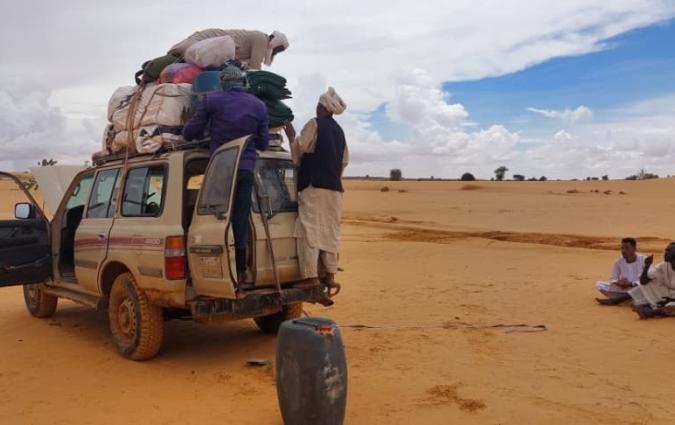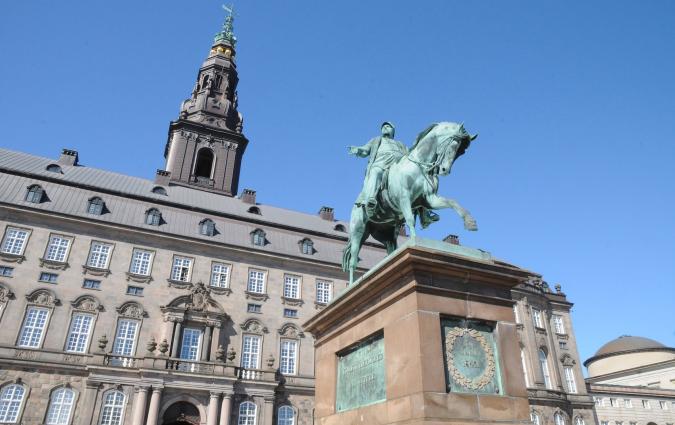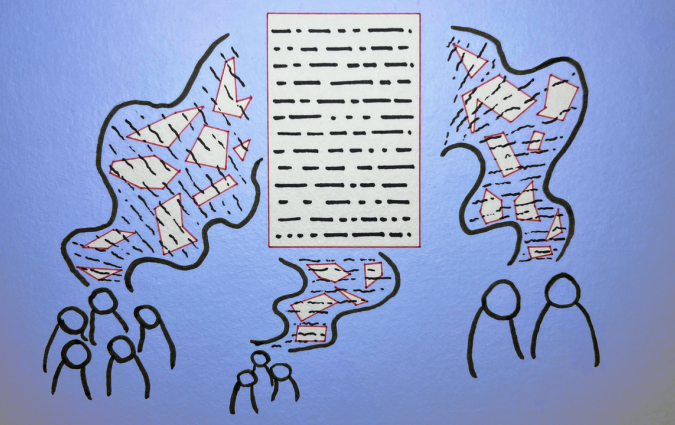How Ethiopian news media have become dangerously divided along ethnic fault lines

Ethiopian refugees who fled the Tigray region sit inside a courtesy bus. REUTERS/Mohamed Nureldin Abdallah
In mid-September 2018, Ethiopia’s capital Addis Ababa was paralysed by a spate of ethnic protests that culminated in the killing of 23 people. The public show of dissent, smothered by the military, fractured a burgeoning attempt by the country’s new reformist Prime Minister Abiy Ahmed to reconcile a nation deeply divided along ethnic lines.
While Abiy’s efforts to mend fences with neighbour Eritrea won him the 2019 Nobel Peace Prize, the ethnic fault lines in his own country have grown deeper. Between 2018 and 2020, the country went through several violent episodes, including an attempted coup in June 2019 and a conflict between the federal and regional authorities in the Tigray region.
As Ethiopia grappled with the initial clusters of social, economic and political disruptions, Dr Mulatu Alemayehu Moges and Dr Terje Skjerdal, journalism researchers at Addis Ababa University and NLA University College respectively, decided to study troubling trends in news items disseminated by media outlets. With the funding of IMS and the Fojo Media Institute, Sweden’s leading media development organization, they both produced a 60-page study report titled “The Ethnification of the Ethiopian Media,” published in November 2020.
The report combines in-depth interviews with about 25 individuals in key positions in media houses spread out across Ethiopia and framing analysis on select stories produced by 10 outlets about eight crucial incidents in 2019. Here are its key findings:
- Ethnic belonging and identity politics are gaining significance as central frames of reference in the current Ethiopian media discourse. The report points to the tendency of journalists to frame issues in a way that aligns with their ethnic background.
- The data points towards a more pluralistic (and more polarised) media society. The authors say the polarisation is fuelled by ethno-nationalistic media of different origin and ownership, and by pan-Ethiopianist channels.
- The previous stronghold of the federal state media – public broadcasters like the Ethiopian Broadcasting Corporation, the Ethiopian News Agency and the three newspapers published by the Ethiopian Press Agency – has been overtaken by a fragmented state media structure with the growing significance of regional mass media agencies. The government’s recent decision to open up the media space has seen the influence of the public broadcasters wane significantly.
- Journalists are starting to form alliances along regional and ethnic fault lines, as illustrated by the launch of the Amhara Journalists Association or the Tigray Journalists Association. They are highly inclined to use sources that support their own ideological interest and avoid quoting sources from other ethnicities which could balance the story.
- Various channels, especially the online platforms that were allowed to operate in the country following the liberalisation of the airwaves, practice a reporting style that mixes acknowledged objective standards for reporting news with the opinions of journalists and media owners. Many media practitioners are deeply concerned about this.
In separate interviews, two Ethiopian practising journalists who have read the report said that they agree with its findings.
Ayele Addis, the president of the Amhara Journalists Association, which brings together media practitioners who speak one of Ethiopia’s two main languages (the other is Oromo), says identity politics is having a huge impact on the Ethiopian media industry. “The polarization of the Ethiopia media is along ethnic lines and the main reason is the government structure,” he says.
Belay Manaye, a journalist with Amhara Satellite Radio and Television, added that the report captured “the reality” across the country. “Ethiopian politics is highly polarised along ethnic lines. This manifested in the media too and it has become difficult to stop because of politics,” he says.
A different landscape
In sentiments echoed by both Ayele and Manaye, Dr Skjerdal, who carried out the interviews and did historical analysis on the media historical development in relation to media and ethnicity, noted that ethnicity has always been an ever-present undercurrent in Ethiopian media and journalism and said the difference today is its scale and scope.
“From the Emperors’ years (1930-1974) many decades ago, ethnicity was really expressed as an exclusion mechanism and it continued to be like that for a long time. But since coming to power in 2018, Abiy Ahmed has quite radically changed the policies towards the media,” he says.
Abiy’s initiative to carry out comprehensive political reforms, aimed at promoting unity in a country whose citizens had suffered under the yoke of oppressive and divisive past leaders, included the release of several journalists from prison and the easing of the hitherto prevalent media censorship.
Such actions improved the media environment in Ethiopia so rapidly that within two years, the country improved its ranking on the Reporters Without Borders’ Press Freedom Index by 51 places, arguably the biggest leap up the table that any country had ever made. It also earned Ethiopia the right to host UNESCO’s World Press Freedom Day in 2019.
However, even as the Ethiopian media basked in its newfound wriggle room, sceptics argued that without institutionalising the reforms, offered through the magnanimity of the new Prime Minister’s leadership, the country could face many challenges. Some of the leaders of the newly unshackled news organizations, for example, are likely to face ethical dilemmas due to their often overlapping media, political and business roles.
“There is [an] equal chance for the change to regress as it can progress. It needs a collective effort from the media, the civil society, and the government to save it from falling into a vicious cycle,” Befekadu Hailu, editor of the Addis Maleda weekly, told the Committee to Protect Journalists (CPJ) in early 2019.
One of the challenges the Prime Minister’s reforms brought about, according to Dr Skjerdal, was the amplification of previously suppressed or localized ethnic disagreements.
“The different viewpoints came to the fore and it was all in the open. The different groups in Ethiopia started to compete against each other for attention, and the other factor is the return of what I call the digital diaspora [people who operated online media organizations abroad but which started establishing media channels in Addis Ababa.] Most of them did not get a license to broadcast but they were producing content. This return of the digital diaspora has also massively impacted the new media situation in Ethiopia,” he explained.
“So many countries within a country”
The liberalisation of the media space paved the way for non-professional media actors. More extremist views became more dominant. Dr Mulatu, who carried out the framing analysis, says they brought out the ethnic divisions that now plague the media in his country.
“By looking at the content from the media outlets, you can see that there are so many countries within a country,” he says. “Sometimes you wonder, ‘Are we really in the same country?’ One issue can be reported quite differently by different media outlets. This is because Ethiopian media is becoming extremely negligent of the other communities. They have their own target audiences, and they don’t care about others.”
The report concludes that increased polarisation in Ethiopia’s journalism is “one of the unsolicited secondary effects” of the new-born media pluralism. “While previous dividing lines were described in political terms, often following a private versus state media axis, the new polarisation is overwhelmingly informed by ethnic interest,” the report says.
That situation has seen the emergence or increase in the influence of largely private media companies and associations that are affiliated to ethnic groups such as Omoro, Amhara, Tigray and Somali. They account for 75% of the country’s population, which explains their considerable political and social influence. Yet the segmentation doesn’t stop there. Even journalists and media outlets from the smaller ethnic groups are similarly coalescing around their ethnic echo chambers, thereby cutting off voices from other parts of an otherwise vast country.
“It is now common to describe media outlets primarily out of their ethnic sympathies. This is most sharply pronounced in newly returned companies such as Oromia Media Network (OMN, Oromo-affiliated) and Amhara Satellite Radio and Television (ASRAT, Amhara-affiliated), but a number of other media institutions have similar commitments to one region or one specific ethnicity,” explains the report.
According to the report, even public media has now fallen victim to the same polarisation. In the past, such official television, radio and print media outlets were largely centralized and would represent the ruling coalition in its entirety. Today, with the rise in regional mass media agencies, the state media entity has seen different regional outlets nurture their own respective distinct identities in line with the most prominent ethnic group in the region where they are based.
“Ownership has become subordinate to ethnic commitment. For example, in the Tigray region, privately-owned Dimtsi Weyane Tigray joins forces with state-owned Tigray Mass Media Agency to counter the media from other regions,” reveals the report.
For Dr Mulatu, who has published several reports and a doctoral thesis about journalism in Ethiopia, a divided media makes it difficult to spread diverse, or even unifying, content within the Ethiopian society. “If someone is watching one television, they are not getting enough balanced and complete information,” he says.
Drawing from his experience, Ayele says every news organisation is pushing its own agenda, not working for the public good. “It is more activism than journalism,” he says.
The impact of this problem is being felt in different ways. It increases the segmentation of media ownership and leadership structures, limits the potential of journalists to grow professionally, and stifles the representation in media outlets across the country.
Roles and interests blurred
While the law in Ethiopia prohibits political organizations from owning media houses, it’s easy to find political figures behind the ownership of news organisations, Dr Skjerdal says.
“If we trace different outlets, we can easily track them down to persons who are politically active and often have ethnic interests. What we have seen is a number of cases where some of the media owners have left journalism and gone into political activity,” explains Dr Skjerdal, who has taught and researched journalism in Ethiopia for almost two decades.
In an environment where the roles between ethnic, political and media actors are so blurred, it is little wonder that the framing of news stories is not a role that journalists play with no undue external influence. According to the report, the Ethiopian media uses the approaches of annihilation and othering to frame stories.
Annihilation includes ignoring important aspects of an ethnic or political group that is perceived as an enemy, blurring sensitive parts of an issue to make it vague, deviation from the main issue, charming the other side, and reporting the issue in a non-ethnic or non-contentious way. Othering means taking information from another outlet to expose what another ethnic group is doing wrong, emphasising a symbolic attachment to stories to create solidarity, victimisation, blaming the other side and undermining others.
Ayele explains that Ethiopia’s currently segmented media landscape has narrowed down the reporting scope and affected the free-flow of possibly unifying ideas. “Journalists are not free to go and report in other regions,” he says. “We have the same ID and the same Ethiopian passport, but because of the ethnification, there is no freedom to cover other regions in the same country. Freedom of movement is limited. Freedom of access to information is limited by region. Because of this, the national consensus is in danger.”
Sören Östergaard Sörensen, programme manager at IMS-Fojo Ethiopia, the initiative that funded the research, says that the study by Skjerdal and Mulatu has helped to clearly identify the red flags in media coverage that begins to be dominated by “us vs them” rhetoric.
“When the democratic winds blow in the country and space for freedom of expression is widened, no regime should be surprised if oppressed ethnic identities will flourish in the media space, not least in social media, like plants met by long-awaited sunshine and rain. This is an asset for the country. The difficult part of it is to ensure that these cultural expressions are not accelerating polarisation and ethno-nationalism,” he says.
For Manaye, the solution lies in the de-ethnicization of Ethiopia’s politics. “Political reform is needed,” he says. “A Constitutional amendment is needed. That would stop media polarisation along ethinic lines in return, and would help the media improve accordingly.”
Ayele agrees and adds there is a need to go further and revise Ethiopia’s media laws to take into consideration the lessons the country should be able to pick from the rampant partition of its media outlets along ethnic lines.
Lessons for other countries
Even as Ethiopia searches for answers to the challenges its media faces today, the authors of the report stress that there are lessons that nearly every sub-Saharan African nation can take from the Ethiopian experience.
Dr Skjerdal says that a considerable number of media practitioners in sub-Saharan Africa tend to underplay the impact of ethnic identification in their analysis of the journalism practiced on the continent. “In most countries in sub-Saharan Africa, you will have a number of ethnicities but when we speak and analyse the media, we are a little bit oblivious to that factor. And yet when you are going to a newsroom, they are well aware of what could be an undercurrent in many newsrooms in Africa,” he says.
It’s impossible not to draw parallels between Ethiopia and Rwanda, a country where news media sharply divided along ethnic lines helped transform a political crisis into a genocide that led to the killing of nearly a million people in the early 1990s. Or between Ethiopia and Kenya, where a journalist was accused of using his radio show to fan the flames of the post-election violence that claimed hundreds of lives and led to the displacement of thousands of others.
In Ethiopia, a country with a violent history, Dr Mulatu has seen a level of caution within the media to suggest that the media will not escalate the situation to a point where massive killings could happen again.
“The media is now becoming a bit cautious,” he says. “In July 2020, the Ethiopian government shut down a couple of media organizations that were using a lot of hate words to incite some forms of conflict in the community. After shutting down those media organizations, such kinds of tense situations were reduced but animosity still exists,” he explains.
And yet both Dr Mulatu and Sörensen agree that a divided news ecosystem could lead Ethiopia to live in a vicious cycle of polarisation and the situation could even force the government to withdraw some of the freedoms that the media has gained.
“There are a lot of progressive freedom-seeking people around Prime Minister Abiy, but there are also more traditional elements holding back. The window of opportunity for more free news media is still open, and it would be sad if the media themselves will be to blame for shutting it,” he says.
Sörensen, his organization and their various partners are now trying to educate more journalists in the country about the dangers of the ethnification of the news media. By late February, some of their partners had held two major events in the cities of Addis Ababa and Bahir Dar, both of which were built around this theme.
Two things that Ethiopians have going for them, according to both Sörensen and Dr Mulatu, are the high number of media training institutions (21 universities offer journalism-related courses) and some similar cultural practices that can serve as a social glue.
Sörensen says the rest of the world should “have patience” with the news media in Ethiopia as it finds its footing after protracted periods of uncertainty and political disorder. “When Prime Minister Abiy came to power, it created unrealistic expectations,” he says. “It will take time before media reform can be rooted. It should take time.”
Benon Herbert Oluka is an Ugandan multimedia journalist, a co-founder of The Watchdog, a centre for investigative journalism in his home country, and a member of the African Investigative Publishing Collective. Oluka’s work has been recognised three times on the African continent as winner of the 2008 Akintola Fatoyinbo Africa Education Journalism Award (First Prize, English category), the 2011 CNN-MultiChoice African Journalist of the Year Award (Tourism category) and the Thomson Reuters’ 2011 Niall FitzGerald Prize for Young African Journalists.






